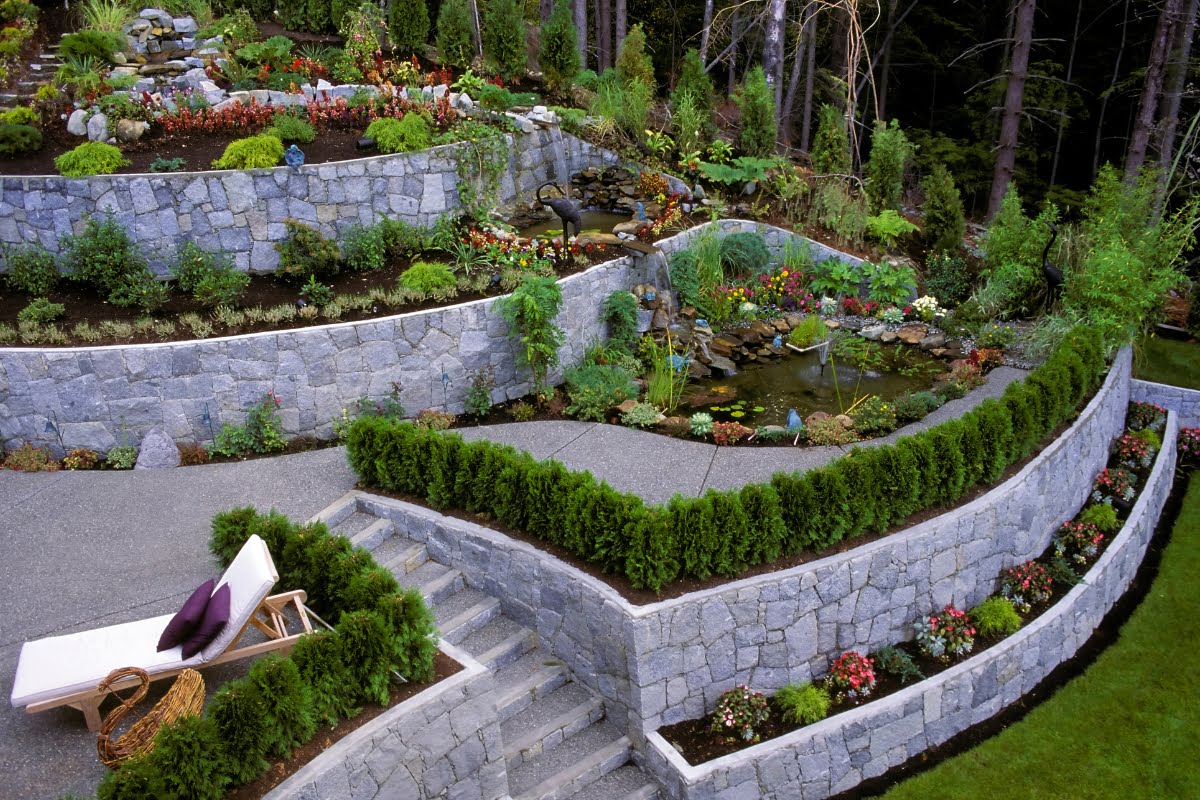Are you looking to transform your outdoor space into a stunning masterpiece? Look no further! In this blog post, we will dive into the world of retaining wall landscaping and explore a myriad of ideas that will elevate the aesthetic appeal of your garden or backyard.
Retaining walls are not only functional but can also be an eye-catching feature that adds depth and character to any outdoor area. Whether you have a sloping yard, want to create terraced gardens, or simply wish to add visual interest, the possibilities with retaining wall landscaping are endless.
So, if you’re ready to embark on a creative journey and reimagine your outdoor space, let’s dive into the world of retaining wall landscaping together. Get ready to be inspired, challenged, and amazed at the endless possibilities that await you!
Unlock Stunning Landscapes with Expert Retaining Wall Ideas!
The Benefits of Retaining Walls in Landscaping
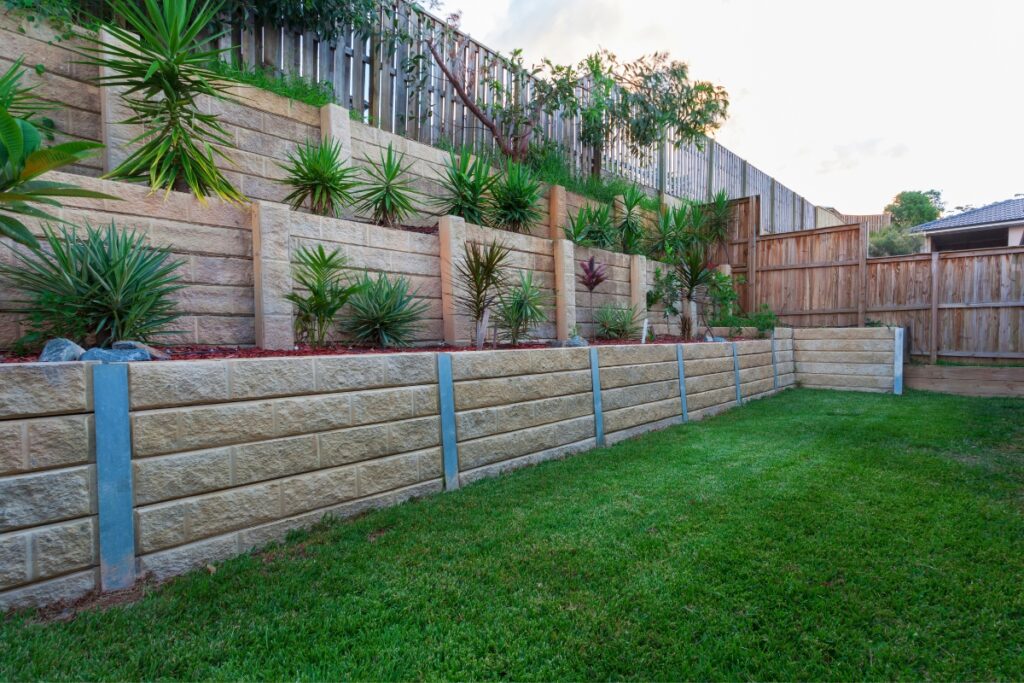
Retaining walls can bring numerous benefits to landscaping projects. Whether you’re looking to create terraced gardens, prevent erosion, or add visual interest to your outdoor space, retaining walls are a versatile and practical solution.
One of the primary advantages of retaining walls in landscaping is their ability to create different levels or terraces. By building terraced gardens, you can make the most of uneven or sloping terrain. This not only adds depth and dimension to your landscape but also provides more planting opportunities. You can create beautiful flower beds, grow a variety of plants, and even incorporate a vegetable garden.
Retaining walls also serve as effective erosion control measures. They help stabilize soil on slopes and prevent the loss of valuable topsoil due to water runoff. By strategically placing retaining walls, you can redirect water flow, mitigating the risk of erosion and protecting your landscape’s integrity. This is especially beneficial for properties located in hilly or coastal areas prone to erosion.
In addition to their functional purposes, retaining walls add visual interest and enhance the aesthetics of your outdoor space. With a wide range of materials, styles, and colors available, you can choose a retaining wall design that complements your overall landscaping theme. Whether you prefer a modern, sleek look or a more traditional and rustic feel, there is a retaining wall option to suit your taste.
Retaining walls can also create defined spaces within your landscape, helping to divide and organize different areas. For example, you can use a retaining wall to separate your patio or seating area from the rest of the garden, creating a sense of privacy and intimacy. Additionally, retaining walls can be utilized to create raised planters, seating walls, or even outdoor kitchen areas, further enhancing the functionality of your outdoor space.
Another advantage of retaining walls is their durability and longevity. When constructed properly using high-quality materials, retaining walls can withstand the test of time and provide long-lasting support. They are designed to withstand soil pressure and hold back heavy loads, ensuring the stability of your landscape even in challenging conditions.
Choosing the Right Materials for Your Retaining Wall
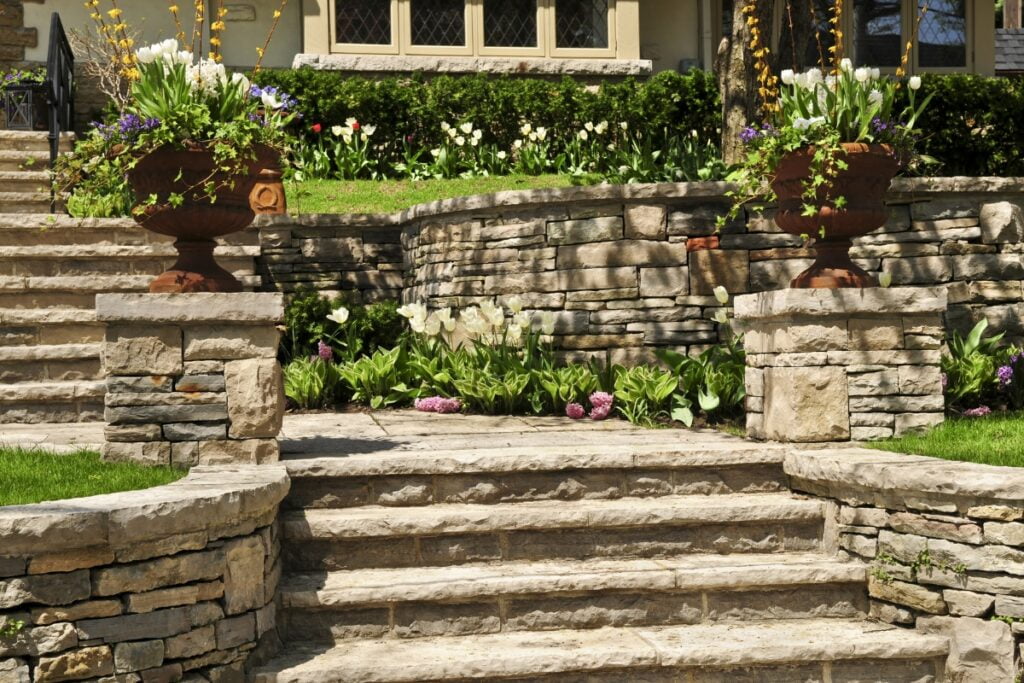
When building a retaining wall, choosing the right materials is crucial for both functionality and aesthetics. The materials you select will determine the durability, stability, and overall appearance of your retaining wall.
- Concrete Blocks: Concrete blocks are a popular choice for retaining walls due to their strength and versatility. They are available in various sizes, shapes, and colors, allowing you to create a customized look that complements your outdoor space. Concrete blocks are durable and require minimal maintenance, making them a practical option for long-term use.
- Natural Stone: For a more organic and rustic feel, natural stone is an excellent choice. Stones like limestone, granite, or sandstone can create a timeless and elegant look for your retaining wall. Natural stone offers a unique range of colors and textures, providing endless design possibilities. However, keep in mind that natural stone can be more expensive and labor-intensive to install compared to other materials.
- Timber: If you prefer a more natural and warm aesthetic, timber retaining walls can be a great option. Timber walls are often used in more casual or rustic settings, creating a cozy and inviting atmosphere. While timber is less durable than concrete or stone, proper treatment and maintenance can significantly extend its lifespan.
- Gabion Baskets: Gabion baskets are wire mesh cages filled with stones or other materials. They provide a modern and industrial look to your retaining wall. Gabion walls are known for their excellent drainage capabilities and can be an eco-friendly option by utilizing local materials. However, it’s essential to ensure proper installation and maintenance to prevent erosion and shifting of the baskets.
- Concrete Panels: For a contemporary and sleek design, consider using precast concrete panels for your retaining wall. These panels are available in various finishes, patterns, and colors, allowing you to achieve a modern look that complements your outdoor space. Concrete panels are durable, low maintenance, and can be a cost-effective option for larger projects.
When choosing the right materials for your retaining wall, consider factors such as your budget, the desired aesthetic, the required durability, and the site’s conditions. It’s also crucial to consult with a professional landscaper or engineer to ensure that your retaining wall meets safety standards and building codes.
Designing a Terraced Garden with Retaining Walls
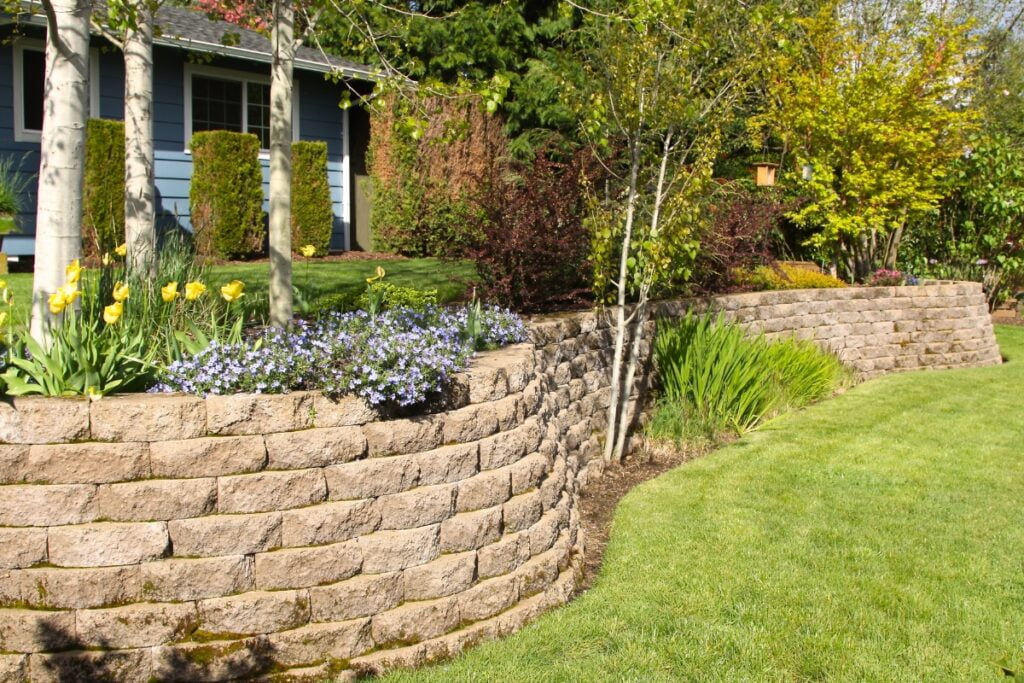
Retaining walls play a crucial role in creating a beautiful and functional outdoor space in a terraced garden. Retaining walls not only provide structural support but also add a touch of elegance and charm to the landscape.
- Incorporate Plantings: Retaining walls offer a perfect opportunity to introduce greenery into your garden design. Consider planting flowers, shrubs, or even small trees along the terraces. This will soften the look of the walls and create a seamless transition between the different levels of your garden. Choose plants that thrive in your climate and require minimal maintenance.
- Add Lighting: Lighting can greatly enhance the visual appeal of your terraced garden. Install landscape lighting fixtures along the retaining walls to highlight their architectural features and create a warm and inviting ambiance. Use uplights to accentuate the texture of the walls and downlights to illuminate the pathways and staircases between the terraces.
- Create Seating Areas: One of the advantages of designing a terraced garden with retaining walls is the opportunity to create cozy seating areas. Incorporate built-in benches or install freestanding furniture on the terraces to provide comfortable spaces for relaxation and entertaining. Position the seating areas to take advantage of the views and create intimate pockets within the garden.
- Consider Water Features: To add a sense of tranquility and serenity to your terraced garden, consider incorporating water features along the retaining walls. A cascading waterfall or a small pond can transform an ordinary garden into a peaceful oasis. Just make sure to consult with a professional to ensure proper installation and maintenance of the water features.
Creating Visual Interest with Unique Patterns and Textures
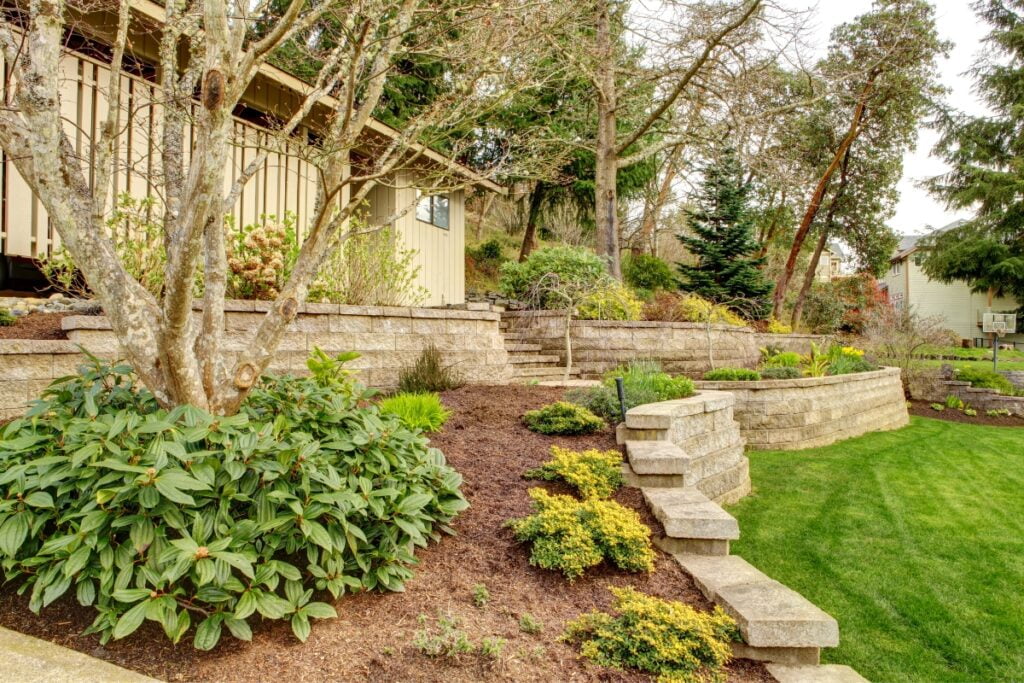
One effective technique is to incorporate unique patterns and textures to create visual interest. By doing so, you can transform a plain and ordinary area into a visually stunning landscape. Whether you are working with a retaining wall or other elements in your outdoor space, adding patterns and textures can elevate the overall aesthetic appeal.
One way to achieve this is by using materials that offer natural patterns and textures. For example, choosing a stone retaining wall with varying colors and textures can add depth and visual interest to your landscaping. Additionally, opting for materials like brick or wood can introduce unique patterns that create a captivating visual effect.
Another method to incorporate patterns and textures is by using different plants and foliage. Plants with interesting leaf shapes, textures, and colors can create a visually appealing display. Consider incorporating plants with contrasting textures, such as rough and textured leaves alongside soft and smooth foliage. This combination can add depth and visual interest to your landscaping design.
In addition to natural elements, you can also introduce man-made patterns and textures into your outdoor space. Using decorative tiles, mosaic patterns, or even intricate metalwork can add a touch of uniqueness to your retaining wall or other architectural features. These man-made elements can serve as focal points and create a visually intriguing landscape.
Furthermore, you can experiment with different hardscaping techniques to add patterns and textures. For instance, incorporating a patterned paver pathway leading up to your retaining wall can create a visually cohesive look. Additionally, using textured materials for seating areas or decorative elements can enhance the overall aesthetic appeal of your outdoor space.
The possibilities are endless with unique patterns and textures. By carefully selecting materials, plants, and incorporating man-made elements, you can transform your outdoor space into a visually stunning landscape. Remember to consider the overall theme and style of your outdoor area to ensure that the patterns and textures complement the existing design. So go ahead and get creative, and watch as your outdoor space becomes a visual masterpiece.
Incorporating Water Features into Your Retaining Wall Design
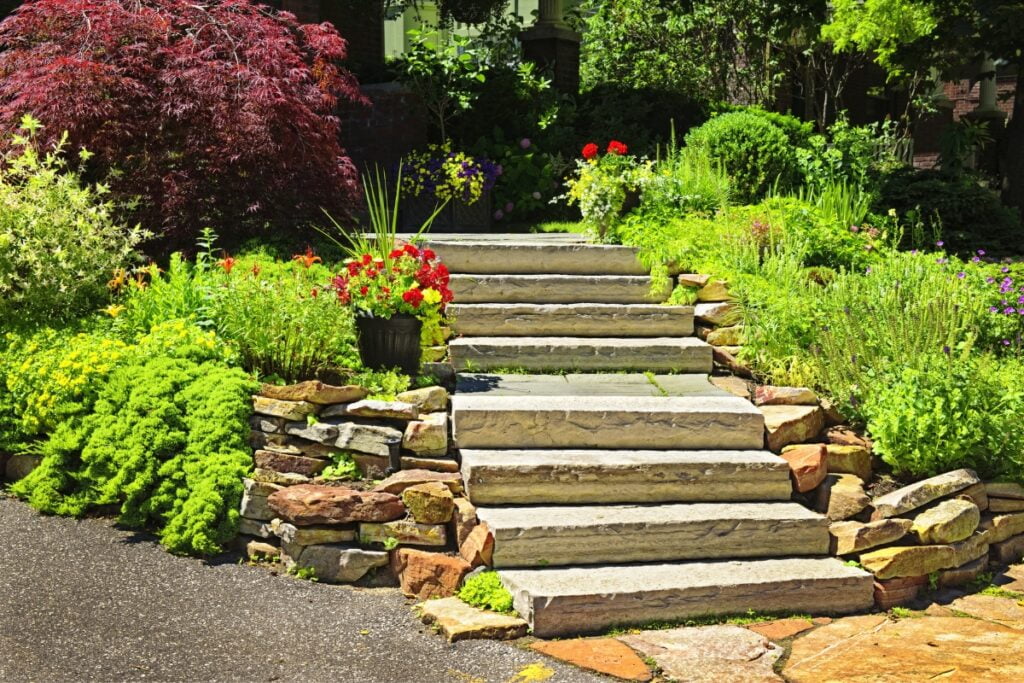
When designing your outdoor space, incorporating water features into your retaining wall can add a unique and captivating element to your landscape. Whether you have a small garden or a spacious backyard, water features can enhance the overall aesthetic appeal of your retaining wall design. By integrating water elements, you can create a soothing and relaxing atmosphere that will make your outdoor space truly stand out.
One way to incorporate water features into your retaining wall design is by adding a cascading waterfall. This feature not only adds visual interest but also provides a calming sound that can help drown out any background noise. You can choose from a variety of styles and sizes, depending on the available space and your personal preference.
Another option is to install a pond or a small water garden within your retaining wall. This not only creates a focal point but also allows you to introduce aquatic plants and fish into your outdoor space. The gentle movement of the water and the vibrant colors of the plants can create a serene and natural ambiance.
If space is limited, a wall-mounted water feature can be a great choice. These sleek and modern designs can be easily integrated into your retaining wall, adding a touch of elegance and sophistication. From simple water spouts to intricate water walls, there are plenty of options available to suit your style and taste.
When incorporating water features into your retaining wall design, it is important to consider the overall harmony of your landscape. Blend the water feature seamlessly with the surrounding elements, such as plants, rocks, and lighting, to create a cohesive and balanced look. By carefully selecting the materials, colors, and textures, you can achieve a visually stunning and harmonious outdoor space.
Adding Lighting to Enhance Your Outdoor Space
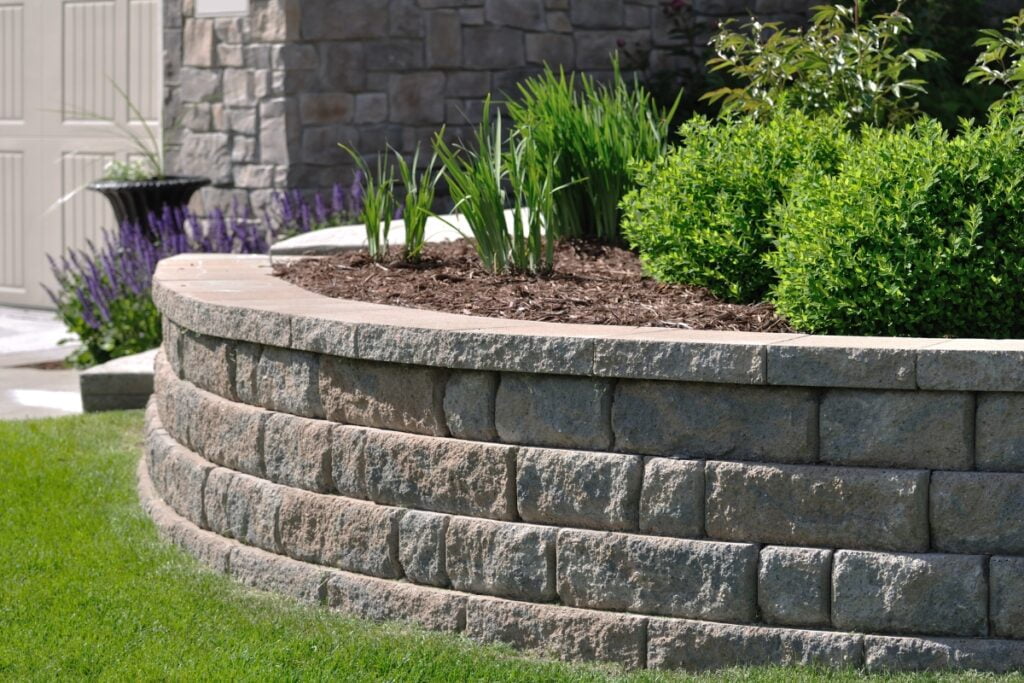
One of the most effective ways to enhance your outdoor space is by adding lighting. Lighting can transform your outdoor area, creating a warm and inviting ambiance. Whether you have a patio, deck, or garden, strategically placed lights can make a significant difference in the overall atmosphere of your space.
Retaining wall landscaping is a popular method of adding both functionality and aesthetics to your outdoor area. By incorporating lighting into your retaining wall landscaping, you can further enhance its beauty and create a captivating visual effect. Here are some ideas on how to effectively add lighting to your outdoor space:
- Pathway Lighting: Illuminate your walkways and paths by installing lights along the edges. This not only adds a touch of elegance but also ensures safety during nighttime. You can use solar-powered lights for an eco-friendly and cost-effective option.
- Accent Lighting: Highlight the unique features of your retaining walls by adding accent lighting. This can be achieved by placing spotlights or wall-mounted fixtures that direct the light towards specific points of interest, such as textured stone walls or decorative elements.
- Step Lighting: If your retaining walls have steps or staircases, consider adding step lighting. This will not only provide functional illumination but also add a visually appealing element to your outdoor space. LED strip lights or recessed fixtures are ideal for this purpose.
- Up Lighting: Create a dramatic effect by using up lighting techniques. Install lights at the base of your retaining walls and direct the light upwards to illuminate the entire structure. This technique adds depth and texture to your outdoor space, making it appear more dynamic and visually striking.
- Water Feature Lighting: If your retaining wall incorporates a water feature, such as a fountain or waterfall, adding lighting can enhance its beauty during the evening hours. Submersible LED lights or underwater fixtures placed strategically can create a mesmerizing effect, highlighting the movement and flow of water.
- Outdoor Dining Area Lighting: If you have an outdoor dining area adjacent to your retaining walls, consider adding lighting fixtures above the seating area. This will not only provide necessary illumination for dining but also create a cozy and inviting atmosphere for entertaining guests. Remember, when adding lighting to your outdoor space, it is essential to consider the overall design and layout. Choose fixtures that complement the style of your retaining walls and the surrounding environment. Additionally, opt for energy-efficient options, such as LED lights, to minimize energy consumption and reduce your carbon footprint.
Maximizing Space with Multi-Level Retaining Walls
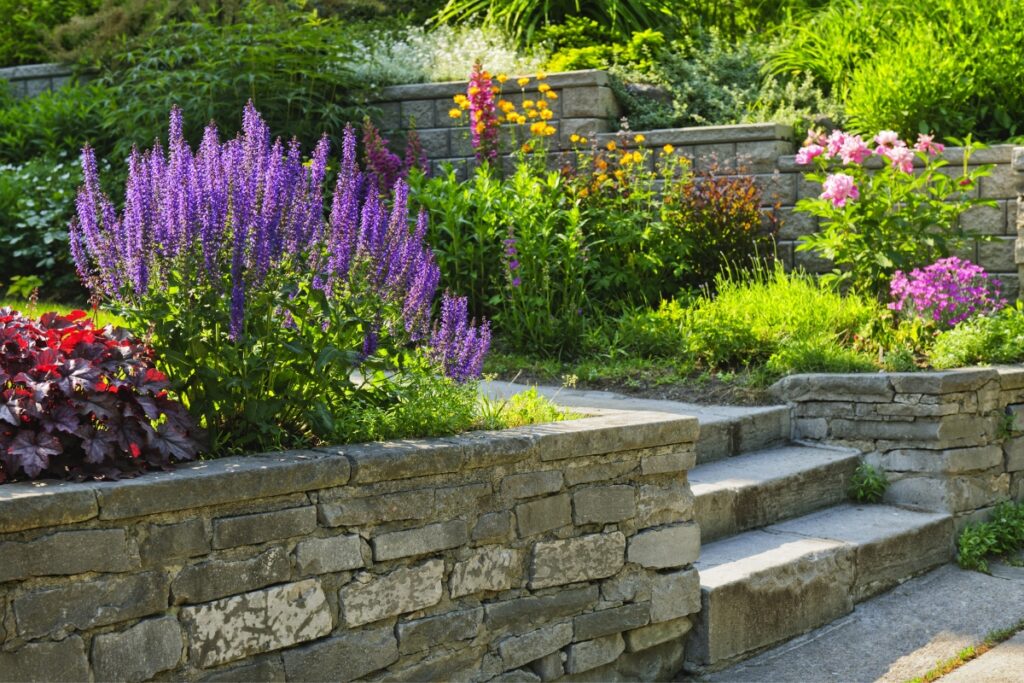
Multi-level retaining walls can be a game-changer for maximum space. These innovative structures not only provide functional support but also add aesthetic appeal to your landscape. By incorporating multi-level retaining walls into your design, you can create different levels and terraces, maximizing the usable space in your outdoor area.
One of the key benefits of multi-level retaining walls is their ability to prevent soil erosion. These walls are designed to hold back the soil and prevent it from sliding down slopes. By installing multiple levels of retaining walls, you can create a stepped effect, which not only adds visual interest but also helps to hold the soil in place.
In addition to preventing soil erosion, multi-level retaining walls can also be used to create beautiful and functional garden beds. By building raised beds on different levels, you can create a tiered effect that allows for easier access to plants and adds depth to your landscape. This is particularly useful if you have a small outdoor space and want to make the most of every inch.
With multi-level retaining walls, you can also create different zones or areas within your outdoor space. For example, you can have a lower level for entertaining, a middle level for planting, and a higher level for a seating area or a fire pit. This zoning not only adds visual interest but also allows you to make the most of your space by creating different functional areas.
Another advantage of multi-level retaining walls is their ability to handle sloped or uneven terrain. If you have a sloping yard, these walls can help you level the area and create a more usable space. By building retaining walls on different levels, you can transform a steep slope into a series of terraces, perfect for planting, seating, or entertaining.
Planting Tips for a Beautifully Landscaped Retaining Wall
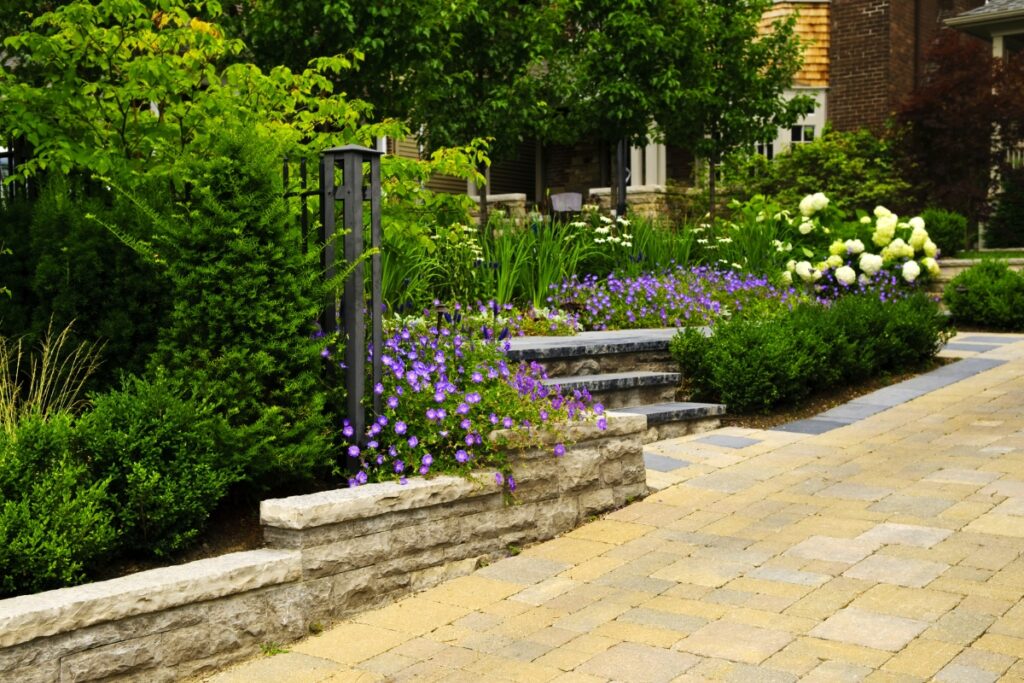
Retaining walls can be an excellent addition to your outdoor space, providing both functionality and aesthetic appeal. Whether you’re looking to prevent soil erosion, create different levels in your yard, or simply add visual interest, a well-landscaped retaining wall can transform your outdoor space.
Choose the right plants
When selecting plants for your retaining wall, consider their adaptability to the specific conditions of your wall. Factors such as sunlight exposure, soil type, and water drainage should be taken into account. Opt for plants that have shallow root systems and can tolerate some degree of drought, as they will be able to thrive in the limited soil space provided by the wall.
Create a layered effect
To create a visually appealing retaining wall, consider adding plants in a layered manner. Start by planting taller shrubs or small trees at the base of the wall, gradually transitioning to shorter plants as you move up. This layering effect adds depth and dimension to your wall, making it more visually interesting.
Incorporate cascading plants
To soften the hard lines of the retaining wall, consider incorporating cascading plants that can spill over the edges. Creeping thyme, ivy, or trailing petunias are excellent choices for this purpose. These plants not only add a touch of natural beauty but also help to create a seamless transition between the wall and the surrounding landscape.
Pay attention to color
The color palette of your plants can greatly influence the overall look of your retaining wall. Consider using a mix of vibrant and complementary colors to create a visually striking display. Additionally, strategically placing plants with contrasting foliage can add interest and texture to your wall.
Provide proper irrigation
As retaining walls can be challenging environments for plant growth, it is crucial to provide proper irrigation. Ensure that your wall has adequate drainage to prevent water accumulation, which can lead to plant stress or even wall damage. Consider installing a drip irrigation system or watering the plants manually to ensure they receive the right amount of water.
Maintaining Your Retaining Wall for Longevity and Beauty
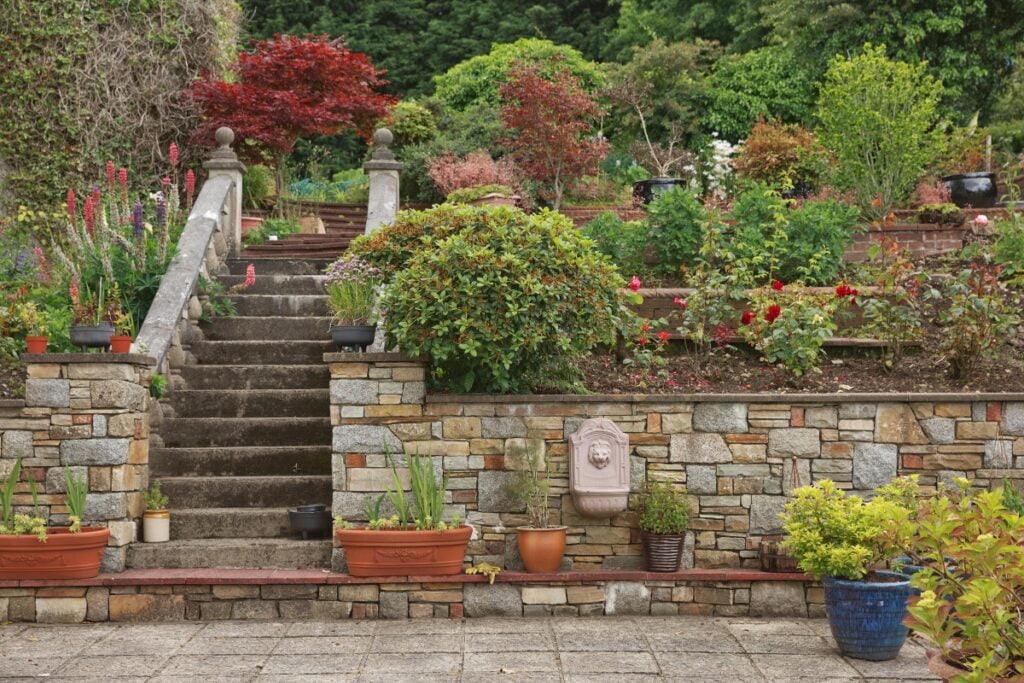
Retaining walls are an integral part of many outdoor spaces, serving both functional and aesthetic purposes. They provide structural support, prevent soil erosion, and add visual appeal to your landscape. However, like any other outdoor feature, retaining walls require regular maintenance to ensure their longevity and beauty.
One of the key aspects of maintaining a retaining wall is to address any signs of damage or wear promptly. Over time, weather conditions and natural forces can cause cracks, bulges, or shifting in the wall. It is essential to inspect your retaining wall regularly and identify any issues that may compromise its stability. If you notice any structural problems, it is advisable to consult a professional to assess the situation and recommend appropriate repairs.
In addition to addressing structural concerns, regular cleaning is crucial in maintaining the beauty of your retaining wall. Dirt, debris, and moss can accumulate on the surface of the wall, detracting from its overall appearance. Cleaning can be as simple as using a hose to wash away dirt or using a soft brush to scrub off stubborn stains. However, it is important to avoid using harsh chemicals or abrasive materials that could damage the wall’s surface.
Another important aspect of retaining wall maintenance is controlling vegetation growth. Plants such as ivy or moss can grow between the crevices of the wall, causing damage over time. Regularly inspect the wall for any signs of plant growth and remove them promptly. Additionally, consider using weed barriers or applying herbicides to prevent unwanted vegetation from taking root near the retaining wall.
Proper drainage is also essential for the longevity of your retaining wall. Improper water management can lead to excess moisture behind the wall, causing pressure and potential structural damage. Ensure that your retaining wall has adequate drainage systems in place, such as weep holes or gravel backfill, to allow water to flow freely and prevent water buildup.
Lastly, consider the long-term durability and stability of your retaining wall by using high-quality construction materials and techniques. Consult a professional during the initial design and construction phase to ensure that the wall is built to withstand the specific demands of your landscape. Investing in quality materials and expert craftsmanship from the start can significantly extend the lifespan of your retaining wall.
Conclusion: Turning Your Outdoor Space into a Breathtaking Showcase
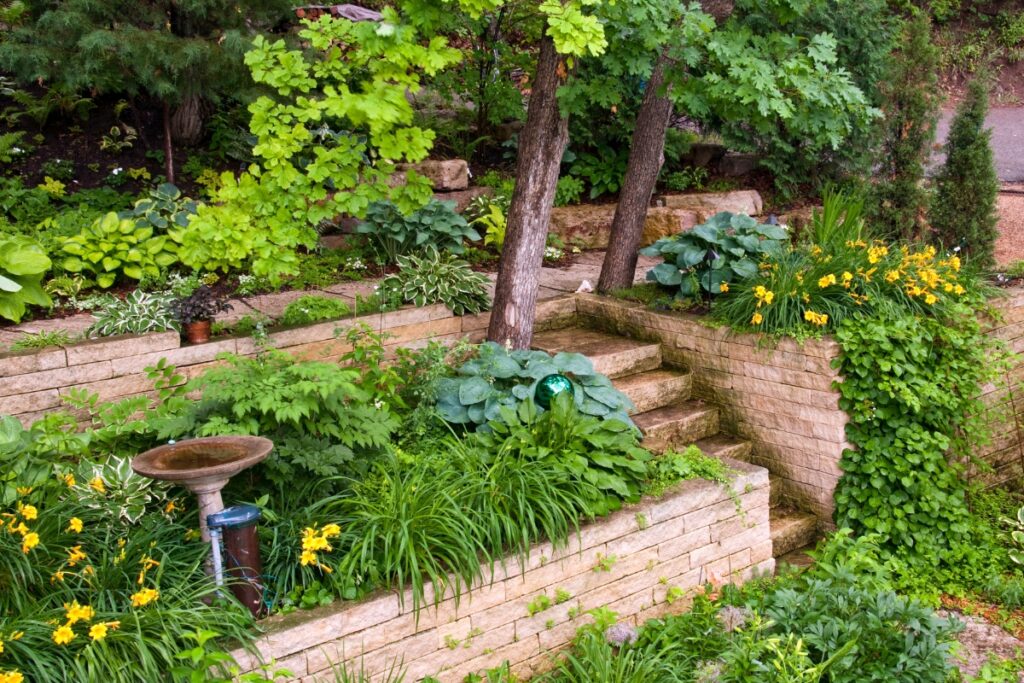
Retaining wall landscaping is a fantastic way to transform your outdoor space into a breathtaking showcase. With the right ideas and design, you can create a visually stunning and functional area that will impress your guests and provide a tranquil retreat for yourself. Whether you have a small backyard or a large garden, incorporating retaining walls into your landscape can add depth, structure, and character to the overall design.
Transforming your outdoor space into a breathtaking showcase with retaining wall landscaping is an excellent way to enhance both the visual appeal and functionality of your yard.
Remember to choose materials that suit your style and consider hiring a professional landscaper for expert guidance and implementation of your ideas. With the right design and attention to detail, your outdoor space can become a stunning showcase that you’ll enjoy for years to come.
Discover the endless possibilities for enhancing your outdoor space with these inspiring retaining wall landscaping ideas. Whether you’re looking to add beauty, functionality, or both to your yard, we’ve got you covered.
For expert landscaping services that will turn your vision into a reality, look no further than Glover Landscapes. Reach out to us at (404) 510-6437 or use our website form to request a free estimate. With Glover Landscapes, you can transform your landscaping dreams into a vibrant reality today!
